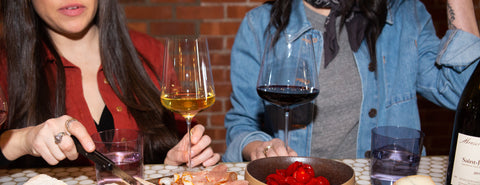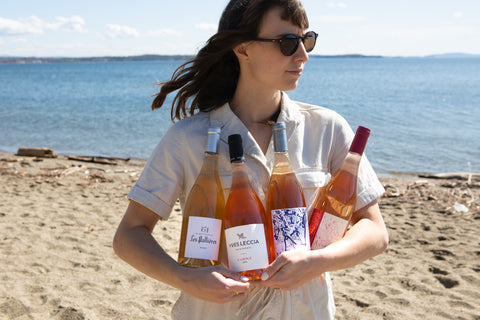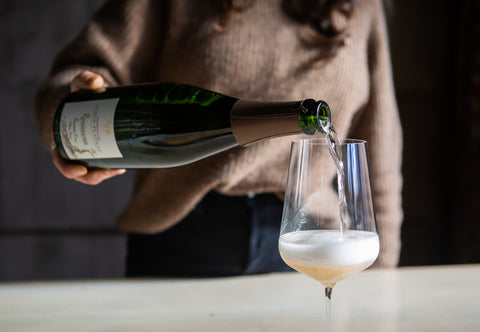Where Did Natural Wine Come From? And What’s Next?
Depending on where you stand, natural wine is either the drink of choice for those in the know or a bedraggled trend on its last legs. A cloudy, brightly colored abomination or an illuminated path to environmental salvation. Savior or villain. Fools gold or 24 carats.
And still, it’s top of mind. It’s gone mainstream. You can’t pop a bottle of Champagne without hitting a natural wine bar in any major city, and most states. But it wasn’t always like this. The movements and people that gave birth to natural wine were counter-cultural. Rebellious. Thoughtful. If it wasn’t for Rudolf Steiner, Jules Chauvet, and the Beaujolais Gang of Four, we wouldn’t be enjoying the proliferation of natural wine — the good, the bad, and the so-so — that we’re seeing today.

The Philosophies Behind Natural Wine
Natural wine is shrouded in mystery and intrigue, mainly because there isn't a single organization with the power to define it. Popular wine fairs, high-brow publications, influential writers, and trailblazing winemakers each champion their own idea of what natural wine is, adding fuel to the fire.
At Dedalus, our take is that the heart of natural winemaking is great farming and minimal intervention. Less is more. That starts in the vineyard, with organic, biodynamic, or other sustainable farming practices, and extends to the cellar, with the use of native yeast and nothing else.
The ultimate goal of this natural approach is to create a wine that feels alive in the glass. A wine that captures the essence of the land, the nuances of the climate, and the unique character of that particular vintage. When done well, wines made naturally have the uncanny ability to convey terroir in an unparalleled manner.
Rudolf Steiner and Biodynamics: A Visionary Approach
Before natural wine took the world by storm, in the 1920s, Rudolph Steiner pioneered the concept of biodynamic farming. The goal of this method is to create a self-sustaining agricultural system. Practitioners of biodynamics rely on crop rotation, livestock integration, adherence to the lunar calendar, the use of "preparation” – potent mixtures of fermented manure, herbs, and minerals — to foster soil fertility and biodiversity.
Many natural wines are crafted from vineyards that embrace the biodynamic philosophy. However, it's worth noting that some esteemed winemakers, such as Daniel Ravier at Domaine Tempier in Bandol and Domaine D'Angerville, practice biodynamic farming but don’t consider their wines “natural.” These revered estates, known for their classical profiles, prefer not to be confined by the trendiness of the natural wine movement, while still upholding the core principles of biodynamic farming and minimal intervention winemaking.

Jules Chauvet and the Renaissance of Natural Wine
Steiner might have laid the groundwork for biodynamic farming, but Jules Chauvet’s influence can’t be ignored. Jules was a negociant winemaker and chemist in Beaujolais. Around the mid-20th century, he began developing his philosophy of winemaking. Since WW2, insecticide and commercial yeasts had become the norm in most wineries, but Chauvet believed it had a negative impact on the quality of the wine. His approach called for minimal intervention in the vineyard and cellar and a return to pre-industrial farming practices; a.k.a., no chemicals.
Chauvet made groundbreaking discoveries in the field of wine science, such as his study of malolactic fermentation, a process that softens acidity, creates complexity, and increases ageability in wines. He was also the first to research carbonic maceration, a technique that transformed the winemaking process, particularly for Beaujolais, resulting in fruity, fresh, and vibrant wines with lower tannin levels.
His research centered on yeasts, something that wasn’t widely understood at the time. Chauvet was an advocate for using indigenous yeasts present on the grape skins instead of commercial yeasts, believing that it led to more authentic, expressive wines. He was a trailblazer, someone who pushed everyone around him to understand wine on a deeper level. His work eventually inspired a group of renegade winemakers in Beaujolais who we now call the Gang of Four.

The Gang of Four and the Modern Natural Wine Movement
Their names were Marcel Lapierre, Guy Breton, Jean Foillard, and Jean Paul-Thévenet. At the time that they took over their respective domaines in the 1970s and onward, Beaujolais star had fallen. The region was synonymous with thin, cheap wine made for mass consumption. Most of the vineyards producing this stuff used those chemicals Chauvet had warned them against. So the Gang of Four took a different approach.
They stripped back their farming and winemaking and focused on making honest, transparent wine that told a compelling story about Beaujolais terroir. Since then, their work has inspired a generation of new winemakers to reconsider the use of chemicals and focus on creating more natural wine. Their juicy, fragrant cru Beaujolais have become ambassadors for the region, winning people over bottle by bottle. American wine importer Kermit Lynch played an instrumental role in catapulting their wines onto the international stage, amplifying their influence and transforming the global perception of Beaujolais.

Mathieu and Camille Lapierre at their domaine in Beaujolais. Photo by Loic Terrier
The Modern Movement and its Flaws
Today, the natural wine movement is thriving. Fairs like Raw, Karakterre, and Viniesta have hopped across the Atlantic, a testament to the increased demand for natural wine from American wine lovers. But the category is not without criticism. There are detractors of natural wine who view it as flawed, referencing cloudy bottles with colors, textures, and aromas that don’t fit in with the conventional ideas about what wine looks and tastes like.
And there are the winemakers who worry about the damage caused by the trend-ification of natural wine. Jonathan Ross of Legend Imports thinks that the hype around the category is creating a rigid view of wine. “When a consumer talks about natural wine, for me, it shows it shows me some interest,” he says in an interview with Dedalus. “I think that the word ‘natural’ or the category ‘natural wine’ has done wine a service in that respect, but I think it's time for us to move beyond that label and have more nuanced conversations. ‘Natural wine’ has become “99 points.” I don't think that that was ever its intention, but it's where it's gone.”
To an extent, he’s right. If you ask someone to pick out the natural wine in a lineup of three wines, they’ll likely point to the one that’s slightly cloudy, in a clear glass bottle, with a colorful label, even if it’s shoulder to shoulder with a Lapierre Morgon. Why? Because that Morgon is in a traditional bottle, with a clean, scripted label. It looks like a classic wine, and therein lies a problem. Natural wine can’t be pegged to a specific aesthetic, which is exactly why we’re telling this story. Because it’s important to remember what started this movement in the first place: A lineage of scientists, winemakers, and farmers devoted to creating better-tasting wine that is healthier for wine drinkers and for the earth.
The Growth and Future of Natural Wine
The natural wine movement has come a long way, from its philosophical roots with Rudolf Steiner and his biodynamic principles to Jules Chauvet's revolutionary research on minimal intervention winemaking. The Gang of Four further propelled the natural wine movement with the help of American wine importer Kermit Lynch, who introduced their wines to a wider audience, solidifying their impact on the global wine scene.
As the popularity of "natty," "funky," and "crunchy" wines continues to soar, it's essential to remember the pioneers and visionaries who laid the groundwork for this thriving movement. Amidst the hype and debates surrounding what constitutes a "natural" wine, we need to shift our focus back to what's inside the bottle and appreciate the dedication and craftsmanship of the winemakers who bring these unique expressions of terroir to life.
The significance of natural wine extends beyond trends and buzzwords; it represents a shift toward sustainability and environmental consciousness in the wine industry. As we face the challenges of climate change and its impact on wine regions worldwide, embracing the principles of natural wine, such as reducing pesticide reliance and promoting biodiversity, becomes increasingly vital.
The future of wine is inexorably intertwined with the future of natural wine. So, with open minds and curious palates, let's celebrate the origins and evolution of natural wine by raising a glass to the pioneers who have made it all possible.



